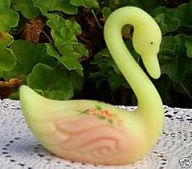Does Burmese glass fascinate you? Read on to find details about how it came into being…
Although Burmese glass ornaments are abundantly available in the market, the original form of the glass was only created for a fairly small amount of time during the end of the 19th century.
Burmese glass pieces were made during the Victorian era and were part of the batch that contained other famous glass wares, so to speak. These glass wares included the Amberina, Peachblow, Agata, Pomona and the Burmese, and all of them were instant hits with the general public of that time.
Popularity of Burmese Glass and its Reasons:
This kind of glass ware was not only popular during the Victorian period but is also in great demand today too. The primary reason for this is the vivid colors that the glass comes in. It has the wondrous colors of a vivid sunset blend into each other in a way that you cannot tell where the yellow ends and the pink starts. However, to this day, the exact shades of color in the glass cannot be ascertained, even by experts.
Also, what makes this glassware extremely popular is the fact that this astounding piece of glass can be either is made to have a shiny smooth finish or a dull matte one. The dull surface of the glass was more popular in the yesteryear, owing to the fact that it was crafted more than the smooth finished one.
Secret of the Matte Surface:
The matte surface of the Burmese is achieved by covering the glass with wax or some other acid resistant surface. The design is then scratched on the surface of the wax and then the glass piece in question is immersed in acid. After the immersion in the acid, the exposed areas of the glass are treated with potassium fluoride.
History of Burmese Glass
Burmese glass was created in the 1880’s by Fredrick S. Shirley. Mr. Fredrick discovered that he could use uranium oxide with specified minerals to create the glass’s unique coloring. The mixture was more or less the one used for the other popular glass of that era, the Amberina art glass, but it also included calcium fluoride and had higher amounts of uranium. Mr. Shirley obtained a patent for his glass formula in 1885.
Popularity with the Queen
There are various accounts relating to Queen Victoria’s liking for the glass. Some state that she ordered a tea set and she really liked the colors of the glass. According to others, the Queen liked the colors of the Burmese art glass so much that she said that they reminded her of the colors of a Burmese sunset, thus the glass’s name. There are also accounts that say that when Thomas Webb and Sons obtained the license of the glass in 1886, they took permission from the Queen to call the glass Queen’s Burmese Ware to honor her.





